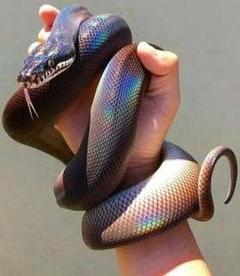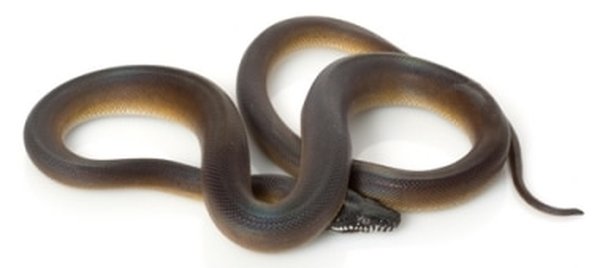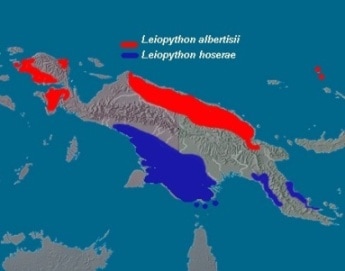White-Lipped PythonGenus Leiopython |

Custom Search
|
|
The White-lipped python snake belongs to the genus Leiopython and so far 6 species of these non-venomous snakes have been identified. From these, 5 species occur on the island of New Guinea and some of the surrounding islands while the other occurs on the island of Biak, in eastern Indonesia.
This formerly monotypic genus was created for the D'Albertis python (Leiopython albertisii), found in New Guinea, and all were formerly regarded as part of the D'Albertis Python species complex. These snakes are mostly found in forested habitats, including coastal palm swamps, monsoon forest, secondary growth and forest margins. These are medium sized snakes with adults ranging between 6 to 9 feet on average far from their biggest cousins like the reticulated python. Their size is variable among species and while the southern white-lipped python can reach up to 9.8 ft (300 cm), the northern white-lipped python reaches on average about 7 ft (214 cm). The white-lipped python rests during the day and becomes active at dusk. Unlike other python species, they are active hunters foraging for prey rather than waiting in ambush. To help them locate prey in the dark they possess heat-sensitive pits in the jaws similar to those of pit vipers.
Their body color is either brownish-violet fading to yellowish on the underside or a blackish-blue fading to gray in the belly. With the exception of the northern white-lipped python that has some markings on its postoculars, they are patternless.
When they mature their skin takes on a very beautiful iridescence in the right light, it's somewhat similar to that of the Brazilian rainbow boa. The head is shiny black, triangular and distinct from the neck. Like their common name indicates the upper and lower labial scales are white. Their teeth are fairly small however, they have the highest number of teeth of any python species. These snakes are considered mostly terrestrial but sometimes are known to climb. But unlike other more arboreal python species found in the region, the white-lipped python doesn't have a prehensile tail. Although these are undoubtedly beautiful snakes the white-lipped python is not as popular as a pet snake as other snake species. This is due mostly to their reputation for having a quick temper and being aggressive. Species / Taxonomy The species was first described in 1878 as Liasis albertisii, by the German Wilhelm Carl Hartwich Peters and the Italian Giacomo Doria. It was named in honor of the Italian ornithologist Luigi Maria d’Albertis (1841-1901) who collected a couple of specimens of the new species and brought them to European museums. These are the 6 species currently recognized. Northern white-lipped python (Leiopython albertisii - Peters & Doria, 1878) - Found throughout almost all of New Guinea always below 1200 m, including the islands of Normanby, Salawati, Biak, Mussau, and Emirau, along with a few islands in the Torres Strait. Wau white-lipped python (Leiopython bennettorum - Hoser, 2000) - These snakes are found in Papua New Guinea. Their specific name "Montanus" derives from the Latin and means "on a hill or mountain". Biak white-lipped python (Leiopython biakensis - Schleip, 2008) - Found in the Indonesian Biak Island, the species was named after the type locality. Karimui Basin white-lipped python (Leiopython fredparkeri - Schleip, 2008) - This species is found in Papua New Guinea. It's named in honor of the herpetologist Fred Parker from Townsville, Australia, for that is sometimes called Fred Parker's White-lipped python Huon white-lipped python (Leiopython huonensis - Schleip, 2008) - The snake is found on the Huon Peninsula on the east coast of Papua New Guinea. The species was named after the type locality. Southern white-lipped python (Leiopython hoserae - Hoser, 2000) - Found in Papua New Guinea in the Western Province, sometimes also called the black white-lipped python. Diet / Feeding
Their diet is comprised of an assortment of mammals and small to medium-sized birds. Neonates and juvenile snakes typically feed upon small lizards. Like many other non-venomous snakes, they kill their prey by constriction.They coiling around their victim, killing it by suffocation and then swallow it head first. After eating a furred prey they sometimes regurgitate castings or fur balls a few days after their meal. Reproduction The mating season occurs from December to March. The white-lipped python is an oviparous species meaning females lay eggs rather than giving birth to live babies. After a gestation period of 3 months, females lay between 5 to 20 eggs, but the average clutch is around 12. The eggs form a compact pile, while the female coils around them and after an incubation period of around 2 months, the hatchlings are born. At birth, they are about 15 inches (38 cm) in length.These snakes become sexually mature within 4 or 5 years. Conservation / Threats The white-lipped python has not yet been assessed for the IUCN Red List. The primary threat to the species is probably the loss of their forested habitat. They are listed in CITES Appendix II.
|
Did You Know?
Because of the "Mojave toxin" the Mojave rattlesnake venom is regarded as the most toxic of any rattlesnake. Scientific classification |
© 2014 Snake Facts About Us | Privacy Policy | Contact





